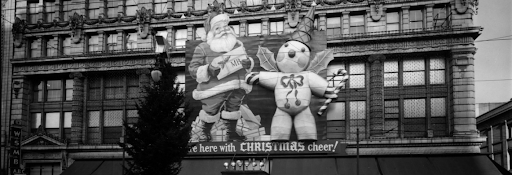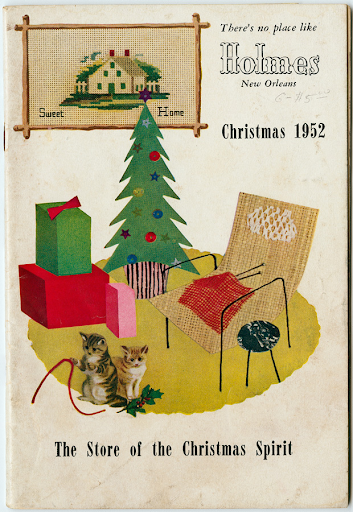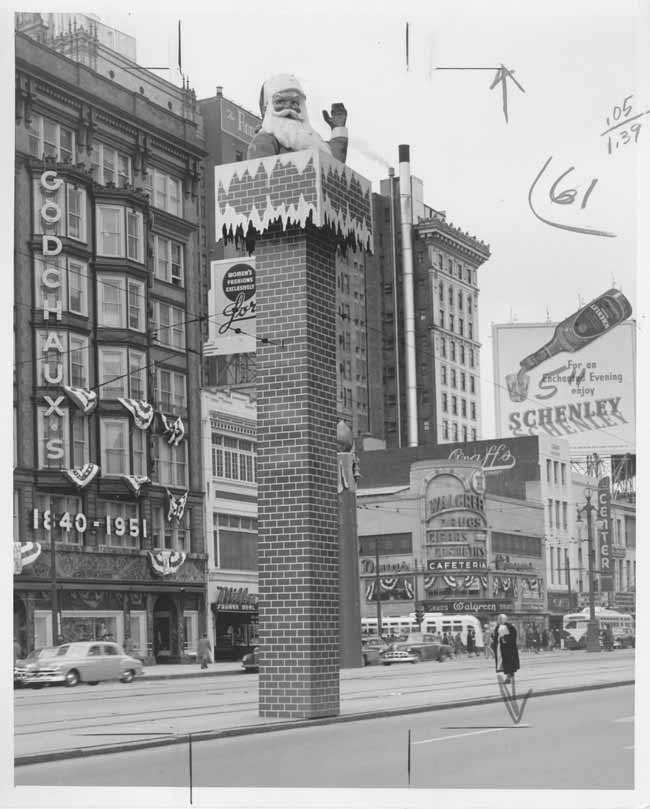Include a Topper!
-
Happy Birthday Banner
$9.00 -
Gingerbread Cake Topper
$15.00
Add Ons
Your cart is currently empty!
Since 1949 celebrating 75 years. Order online or call us at 1 800 GAMBINO (426-2466)


Canal Street in New Orleans is a magical place at Christmas. Snow appears in Fulton Alley despite temperatures often being a balmy 70 degrees, streetcars and lamp posts bear wreaths, and thousands upon thousands of lights glow throughout the giant live oaks of City Park. Countless people take in these sights every year, often stopping to pick up a present or two along the way. But what many may not realize is the importance Canal Street played in creating many of the holiday traditions New Orleanians enjoy today.
Although instantly recognizable today, Canal Street didn’t make its New Orleans’ debut until the early 1800s. Originally planned as a large canal in 1807, the waterway was never dug despite already having been placed on several maps of the area. Since the canal wasn’t to be, the cleared area with its wide lanes and substantial median, called the “neutral ground”, became the inevitable place for Creole French Quarter residents and Uptown Americans to meet.
While the two groups were divided by religion and social customs, both found the shops of Canal Street accessible and convenient for their needs. Since New Orleans at the time was one of the nation’s most important ports, Canal Street shop windows boasted goods from England, France, and more exotic locations to tempt patrons inside. These shop windows morphed into lavish Christmas displays beginning in the late 1860s and continued to evolve well into the 1970s.

Newspaper reports in 1865 cited the throngs of people parading about Canal Street on Christmas Eve and Day. Firmly cemented as the city’s main thoroughfare at this point, everyone wanted to show off new holiday clothing and particularly rich gifts of Parisian made jewelry or gold handled umbrellas. Without fail, all of these gifts had come from the increasingly larger department stores which had begun to populate the street.
Stores such as Maison Blanche, Rubenstein’s, D.H. Holmes, and many more became synonymous with Canal Street. Starting in the 1870s, as Americans became more familiar with old Saint Nick, these department stores offered children the chance to meet Santa himself if they brought their parents in. Eventually, the larger stores began to create their own Christmas characters to promote items and provide photo opportunities for families.
In 1947, Maison Blanche presented Mr. Bingle, a mistletoe winged, ice cream cone hatted snowman, to the public. Mr. Bingle was a special messenger for Santa Claus and the two appeared together, several stories tall, on the Maison Blanche building for many years. For those looking for more affordable options, the Sears located at Baronne boasted a plywood Santa 40 feet tall mounted on their building holding a wrapped present. Aside from the spectacle of larger-than-life characters, Canal Street also boasted elaborately decorated window displays full of automated toys and costly electric lights.
Hard as it may be to fathom now, electric Christmas lights were once a very expensive commodity. Now only did you have to invest in the lights, but you had to be able to pay for the extra electricity. Many families weren’t able to do this, but, as a thank you to the community that had made them prosperous, Sal and Myra Centanni began to decorate their Mid-City home with a lavish display of lights.
Located on the Canal Streetcar line, the home was clearly visible to all who rode by and many New Orleanian’s made a point to take the family by the Centanni’s every year to see the display. When Mrs. Centanni died in the 1960s, Sal donated many of the decorations to City Park for their light display.

As more and more people left the city for the suburbs throughout America, shopping began to move from local streets to shopping malls. That trend saw the century old tradition of a Christmas gift-getting pilgrimage to Canal Street come to a close in the 1970s. While the famous Canal Street department stores are mostly gone now, remnants of them remain.
The elaborate lights of display windows now fill Canal Street hotels like the Roosevelt and the Sheraton. Mr. Bingle returns yearly to Dillard’s department stores to reign once again over holiday goods. And that City Park display Mr. Centanni donated his lights to? That’s become the annual Celebration in the Oaks, host to not only millions of lights throughout the park but also one of the large Mr. Bingles which once graced the Maison Blanche building.
So, as you gather with family this holiday season, cut everyone a slice of Gambino’s Kringle Cake and listen to your elder’s stories of New Orleans’ Christmases past.